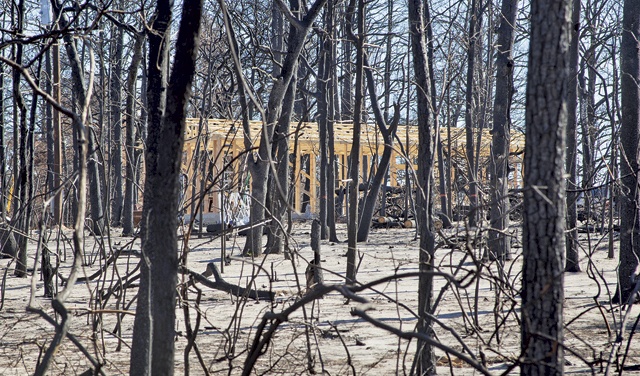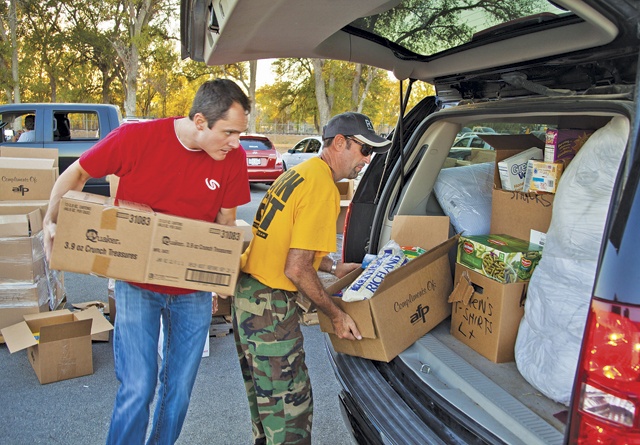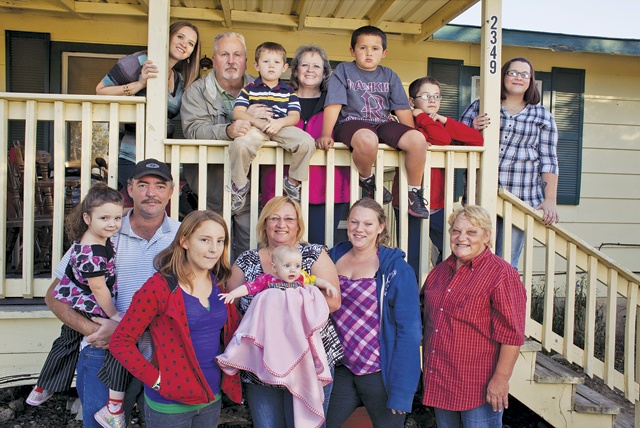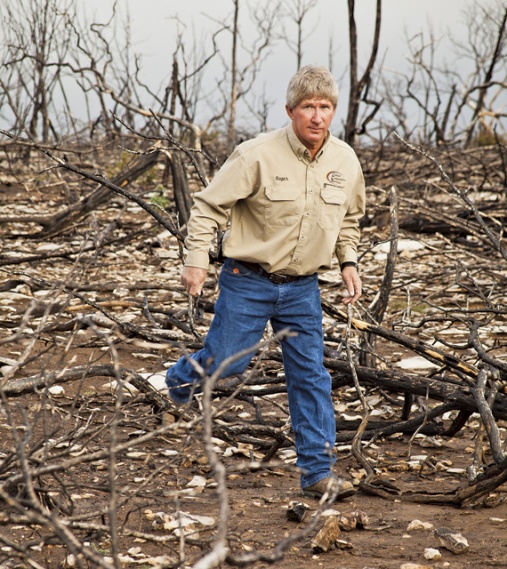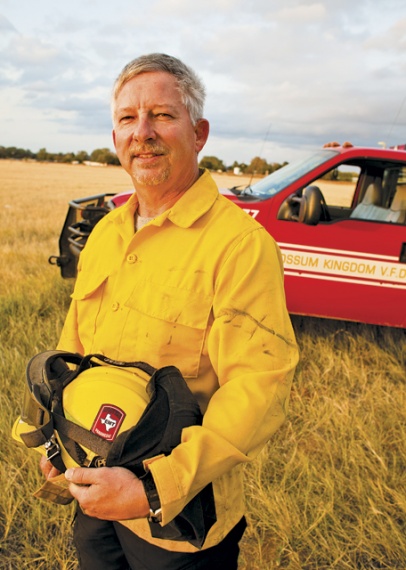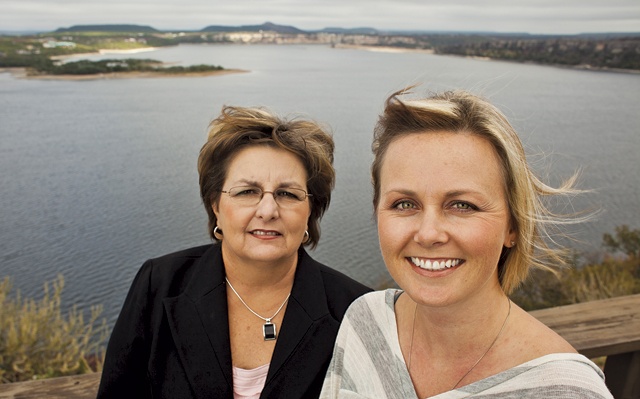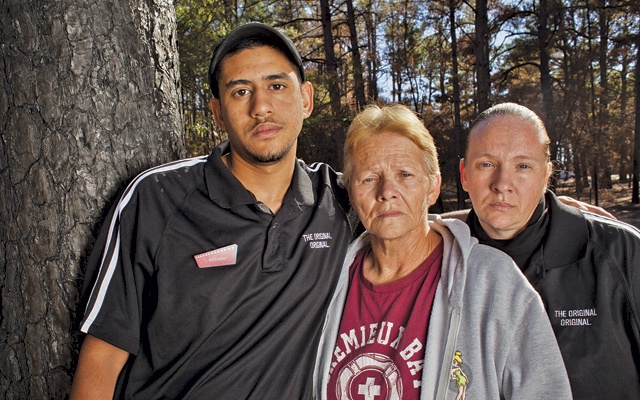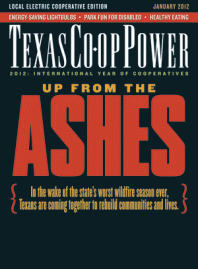When Larry McClintock and his 20-year-old grandson Anthony returned home to Paige from Austin, where they had gotten a flat tire fixed, they bounced the repaired tire from the pickup bed and rolled it to a tree trunk, propping it there next to the house. Then they went inside to relax for just 10 minutes before mounting the tire on the car from which it came.
That was on September 4. Little did they know on that blustery Sunday that they wouldn’t need to mount the tire at all. That they’d be fleeing the scene in 10 minutes, and almost immediately after that, the tire would be ablaze and would burst, the tree would be on fire, the car would be an inferno so hot that its tempered glass would melt, and their home would be reduced to ashes, just like the home next door, just like every home on their stretch of Cardinal Drive and more than 1,600 homes in surrounding communities.
They all went up in a sky-blotting nimbus of billowing ash in a wildfire so big it was visible from outer space.
With sirens blaring, units from the sheriff’s office and fire department burst upon the neighborhood. The McClintocks, who were relaxing indoors, were unprepared for the scenes of chaos when they went to the door.
The officers “were using their loudspeakers, saying, ‘Evacuate immediately—your lives are in danger!’ ” said Larry’s wife, Peggy McClintock.
“It was terrifying,” she said. “Totally unbelievable. We didn’t even have time to get a toothbrush. When we went out on our front porch, the fire was directly across the street from our house, in our neighbor’s backyard.”
The fire was devastating in its fury.
“The lady from the sheriff’s department pulled into our driveway,” Peggy said. “I told her we had to get our dogs. She told us to just turn them loose. I insisted we had to get them.”
The McClintocks gathered their two dogs and hurried into the Ford pickup, turning left with the flow of traffic. There was only one way out—south on Cardinal, which intersects with State Highway 21 northeast of Bastrop. The narrow, twisting, forest-hugged, normally lightly trafficked two-lane road was already jammed with vehicles. What should have taken but a few minutes took 15 to 20. “You were seeing all this smoke and fire,” Peggy said. “You could hear propane tanks blowing up.”
Complicating matters was an 18-wheeler truck cab, sans trailer, blocking the road as its driver tried to turn around to head south. As other drivers honked their horns, the procedure seemed to take forever, Peggy said. Finally, the truck was moving, with trees ablaze all around.
“When we got to the end of Cardinal, we stopped, got out of the truck, and watched our subdivision burn,” Peggy said.
Put to the Test
The Bastrop County Complex fire, which made national headlines, consumed more than 34,000 acres. Other wildfires have been larger, but the Bastrop blaze destroyed the most homes, making it the single-most destructive fire in Texas history.
Nor have the losses been confined to Bastrop. As of November, one year after what was to become Texas’ worst-ever wildfire season began, more than 4 million acres had been scorched—more land area than is found in Connecticut.
Bluebonnet Electric Cooperative, which serves the Bastrop region, was put to the test as perhaps no cooperative had been previously.
Bluebonnet Chief Operating Officer Matt Bentke said the immensity of the event struck home very quickly when employees had to evacuate the co-op’s headquarters just as the wildfire was sweeping its service area. Later, they would find that the building itself was spared, but at the building’s perimeter, the burn zone went “360 degrees—all the way around,” Bentke said.
Eight Bluebonnet employees lost their homes to fire. “Some were actually working that [Sunday] afternoon, and that evening, while they knew their homes were burning,” Bentke said. “They never missed a beat—just worked hand in hand with the rest of our employees, doing the things that had to be done.”
While the office staff evacuated to the co-op’s alternate control center, Bluebonnet field crews were working side by side with firefighters and emergency response teams.
“They were de-energizing lines out in front of the fire, to make it safe for everyone trying to evacuate and for those trying to fight the fire,” Bentke said.
When Bluebonnet was finally allowed into the burn zone—and that was not until three days later—the hands-on restoration effort began in earnest. There were 1,000 poles to replace, 56 miles of line and—hardest of all—252 miles of right-of-way to clear of debris. Some 400 workers were in the field beginning that Wednesday, most of them from outside the region.
Bentke summed up what he and Bluebonnet have learned from this event. “When faced with such challenges,” he said, “people have an innate ability to set aside personal needs and go beyond what is normal and what is expected, all for the benefit of others. And those others could be people they may never know or ever expect to receive thanks from.”
Bringing Out the Best in People
The Bastrop County Complex fire came close on the heels of another one, the late-August blaze that swept much of the Possum Kingdom Lake area. An earlier, larger fire in April had swept through the same area served by United Cooperative Services (UCS).
Marty Haught, senior vice president of communications and public relations at UCS, said the Possum Kingdom area lost 400 poles in April and 120 poles in August. About 30 UCS-serviced structures—mostly homes—were consumed in the August fire, Haught said.
The August wildfire, a stunning conflagration called the 101 Ranch Fire, started on ranchland outside the community of Possum Kingdom but raced northwest and jumped State Highway 16 before sweeping into the upscale residential enclave known as The Cliffs, overlooking Possum Kingdom Lake.
The flames were so hot—firefighters estimated the temperature at 2,500 to 3,000 degrees—that homes were igniting even ahead of the wind-driven fire line. Cedars across the tree-clad plateau were exploding into flames. Observers estimated that some of the flames leapt as high as 100 feet into the air.
The earlier, grim experiences of April, which fetched seven neighboring co-ops to UCS’ side, provided invaluable lessons. “One of the most impressive things to me was seeing [in August] how our line crews knew just exactly what to do,” Haught said. “They assessed the situation, developed a strategy and went right to work. It was extremely inspiring.”
The day after the fire, UCS deployed 50 employees into the burn zone, and all power was fully restored by 4 p.m. the following day, September 1. The April power restoration, by comparison, took nine days.
“A local real estate company, Pondera Properties, and the Lake Country Sun newspaper did a masterful job coordinating information for the community,” Haught said. “They were instrumental in broadcasting our restoration efforts to our members.”
Other local organizations also rushed to help, including the Possum Kingdom Chamber of Commerce, which served meals to firefighters and line crews.
“I honestly think Possum Kingdom will be even stronger in the future than it was before. The people really came together, and we’re grateful to be a small part of such an inspiring community,” Haught said.
Fredda Buckner, general manager at Big Country Electric Cooperative, oversaw her co-op’s restoration efforts in Fisher and Kent counties after a widespread April wildfire that threatened the towns of Rotan and Roby, the co-op’s headquarters location.
Dubbed the Cooper Mountain Ranch fire, after its starting point, the blaze started moving toward Rotan on April 14, before a wind shift took it southeast, toward Roby, some 10 miles distant. As the fire came closer, things got frantic, Buckner said. “There was smoke in the air. You could drive out from town and see the blazes.
“We spent the 15th preparing to evacuate our headquarters, until, by the grace of God, the wind changed again, and the fire didn’t get to Roby,” Buckner said.
It would not be until April 22 that firefighters proclaimed the fire “under control,” and the task of restoration could begin. Fully 162,625 acres, mostly ranchland, were consumed—almost five times as many acres as the Bastrop County Complex fire would destroy.
“It burned pasture grass, fences and animals,” Buckner said. “We lost barns. Not many homes. About 350 poles were destroyed in that fire. A lot of oilfield flow lines were destroyed, and a lot of people sold their cattle because there was no grass and no fences.”
But then came a gradual but growing resurgence of energy and effort, both within Big Country Electric, which has lost approximately 500 poles to wildfires, and within the communities at large.
“People were pitching in, gathering cattle for each other, finding temporary placements for the animals,” Buckner said. “The first night—the night they were evacuating Rotan—the churches in Roby opened up their doors. The Red Cross came in and brought cots. People were bringing food. They were coordinating volunteers who were opening their homes to evacuees from Rotan.
“The guys worked very long hours each day,” Buckner said. “They’d come in around 10 at night and rest until daybreak. In the earliest going, some of our people worked around the clock, while our other people were getting them food and assisting any way they could. A disaster really brings out the best in people.”
Generosity and Compassion
On October 4, a month after the Bastrop County Complex inferno, the soccer grounds adjacent to Bastrop High School were turned into a distribution center for fire victims. Coordinated by Austin Disaster Relief Network, a cooperative effort of about 100 area churches, the event embodied generosity and compassion from thousands of contributors and volunteers.
It took an 18-wheeler truck and trailer to lug all the donated goods. From 5 p.m. until well after dark, a seemingly endless line of vehicles pulled through the circle as volunteers heaped commodities, clothing and other supplies into the cars or tumbled them into pickup beds.
Organizers stockpiled three warehouses full of donations that came pouring in after news of the Bastrop County fire went national. The warehouse space was donated rent-free by area businesses.
Mike Sattler, an event coordinator, said fire victims were in disbelief when they saw what awaited them. “Some of them were crying,” he said. “It was almost like Christmas. We were filling everyone’s car with stuff. We wished we could’ve done more, but they couldn’t hold it all anyways.”
There looked to be enough groceries to accommodate the nightly restocking in a supermarket. And the relief network was able to transport “food, pillows, blankets, towels, cleaning products and supplies, comforters, bedding, shoes, jeans, shirts,” Sattler said.
‘We Will Go Back’
Peggy McClintock was among the fire victims to go through the line that evening in Bastrop. She picked up food, water, bedding, toiletries, towels and other goods.
Peggy acknowledges that she and her family, who were uninsured and live on a fixed income, are hard-pressed by the circumstances, and the weight of the disaster still hangs heavy on them. But she is equally emphatic that they will find a mobile home—a used one will be the best they can possibly do—and again take their crack at Cardinal Drive.
Why?
“Because it’s home!” Peggy said, almost choking on the words. “We’ve been there for more than 30 years. Even though it’s burned to the ground, I don’t feel comfortable anywhere else. We broke our backs clearing that land. There was nothing but trees on top of trees. Stickers, brush, you could not imagine. You literally could not see onto the property because of the underbrush.”
“We are determined to go back,” she said quietly. “We will go back.”
——————–
Jesse Mullins, a freelance writer, lives in Abilene.
